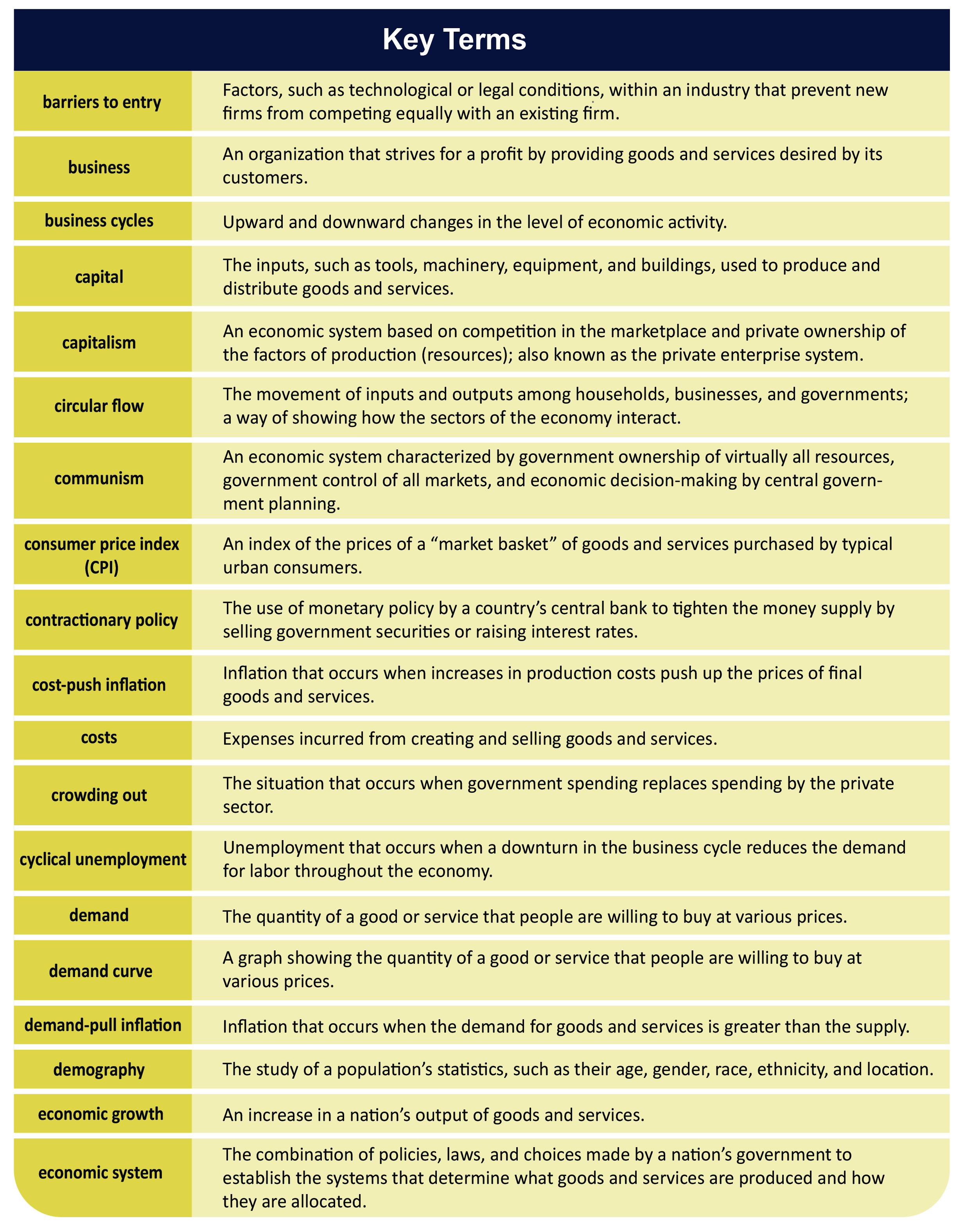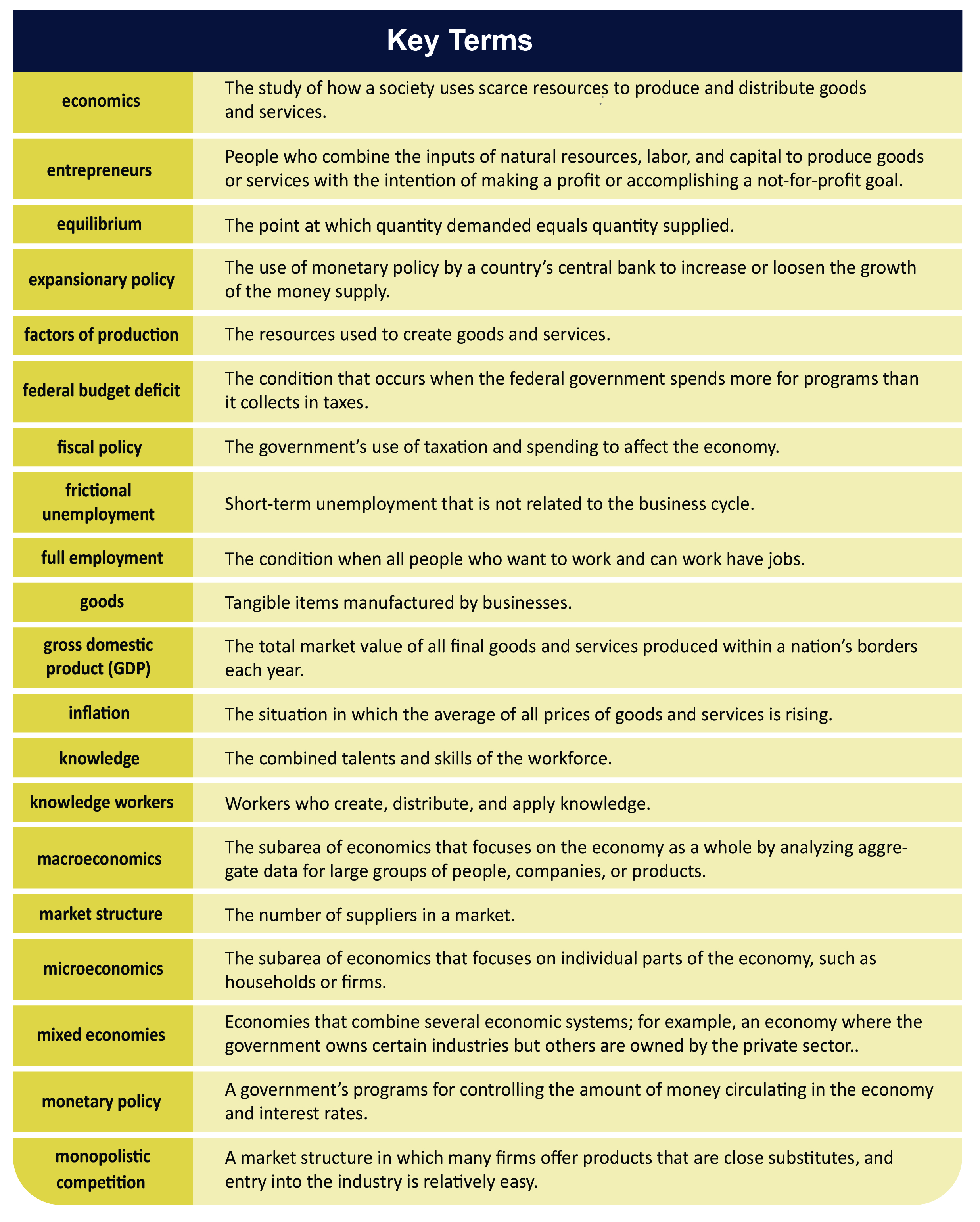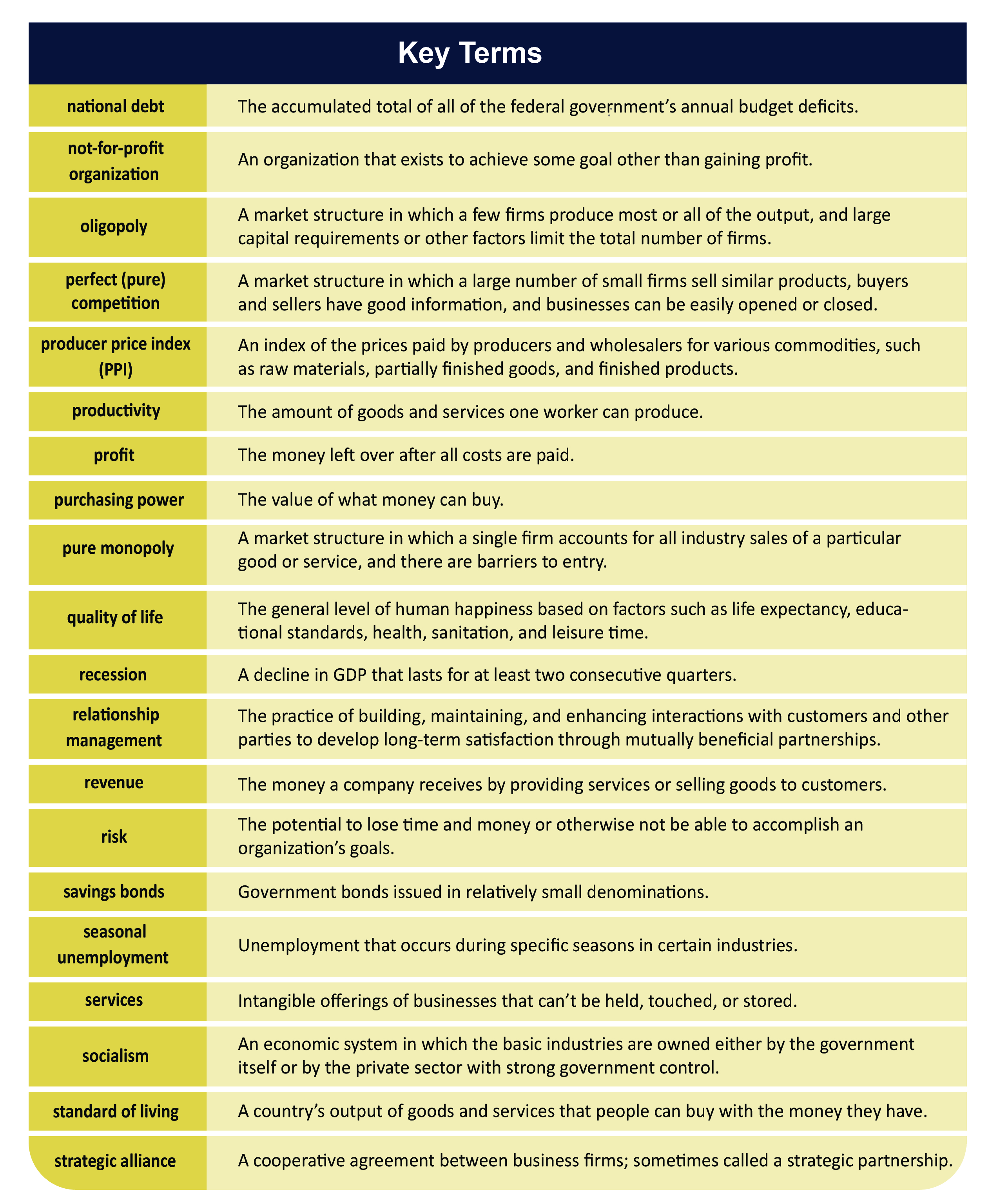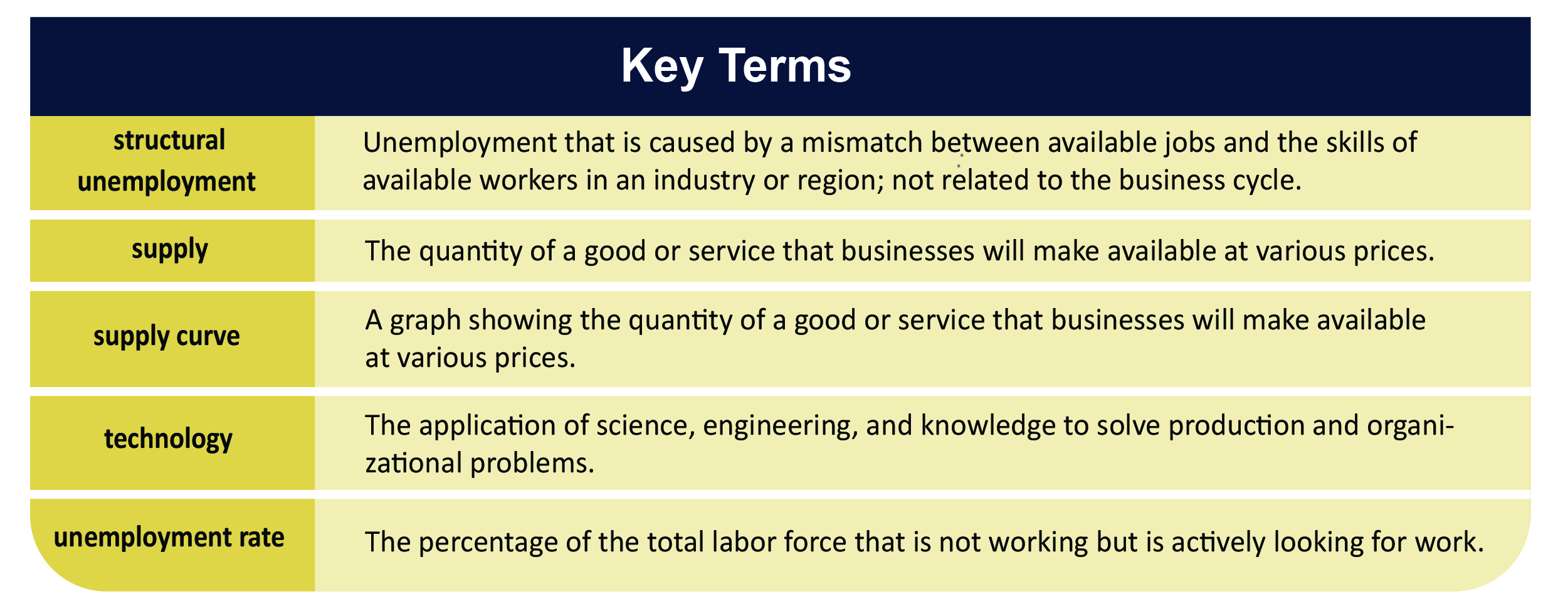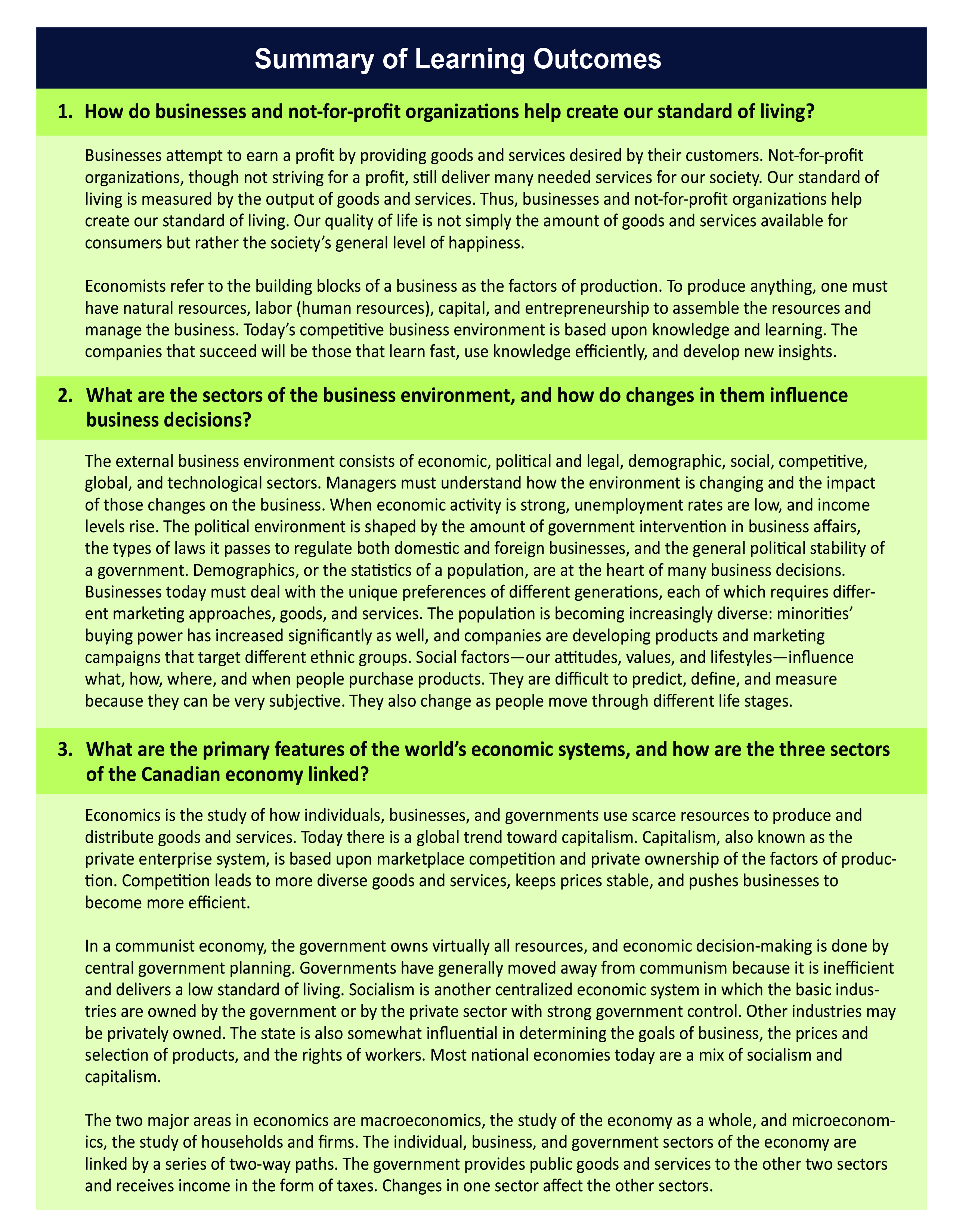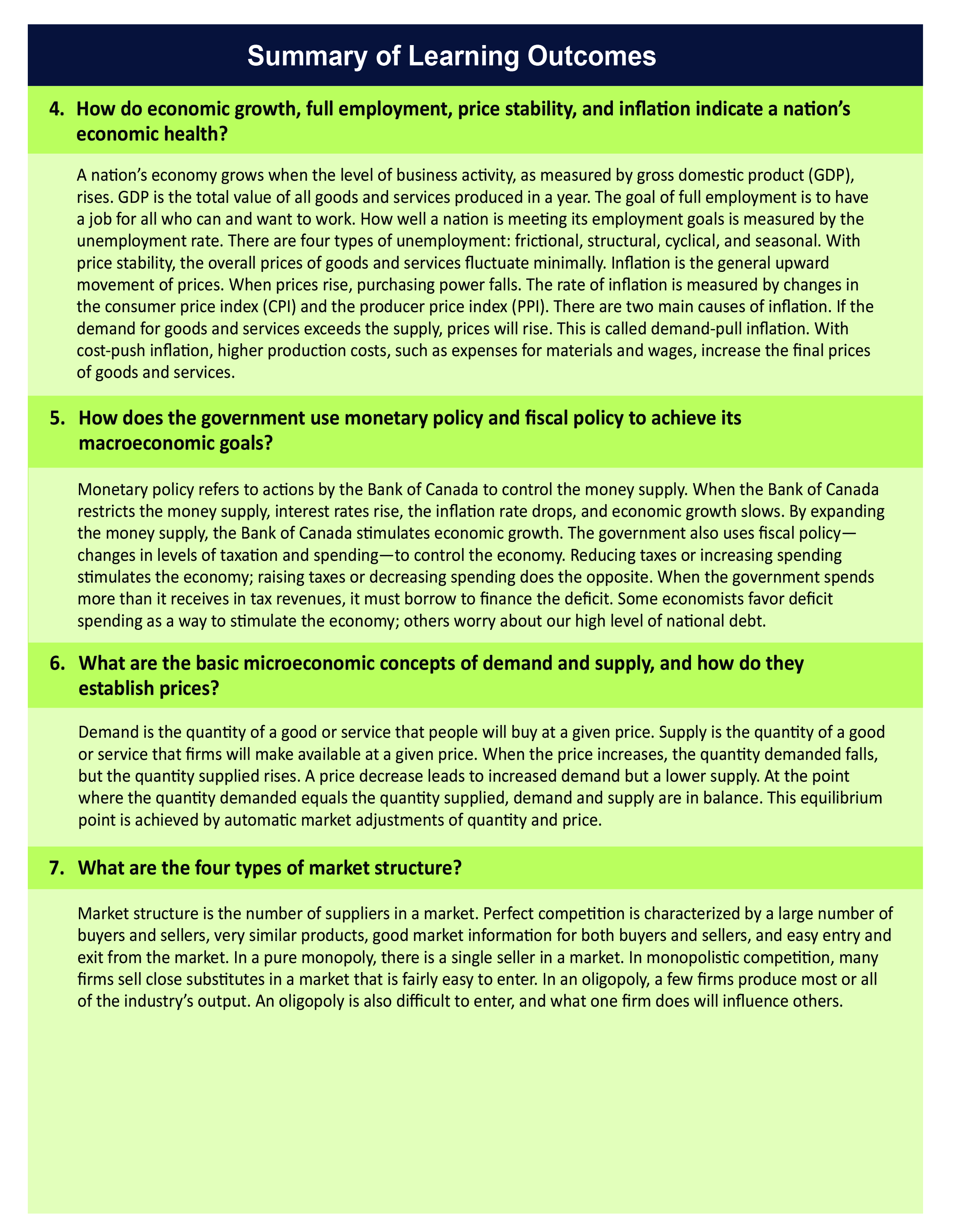Chapter 1: Economic Systems and Business

Learning Objectives
After reading this chapter, you should be able to answer these questions:
- How do businesses and not-for-profit organizations help create our standard of living?
- What are the sectors of the business environment, and how do changes in them influence business decisions?
- What are the primary features of the world’s economic systems, and how are the three sectors of the Canadian economy linked?
- How do economic growth, full employment, price stability, and inflation indicate a nation’s economic health?
- How does the government use monetary policy and fiscal policy to achieve its macroeconomic goals?
- What are the basic microeconomic concepts of demand and supply, and how do they establish prices?
- What are the four types of market structure?
1.1 The Nature of Business
How do businesses and not-for-profit organizations help create our standard of living?
Take a moment to think about the many different types of businesses you come into contact with on a typical day. As you drive to class, you may stop at a gas station that is part of a major national oil company and grab lunch from a fast food chain such as Taco Bell, McDonald’s, or the neighbourhood pizza place. Need more cash? You can do your banking on a smartphone or another device via mobile apps. You don’t even have to visit the store anymore: online shopping brings the stores to you, offering everything from clothes to food, furniture, and concert tickets.
A business is an organization that strives for a profit by providing goods and services desired by its customers. Businesses meet the needs of consumers by providing medical care, automobiles, and countless other goods and services. Goods are tangible items manufactured by businesses, such as laptops. Services are intangible offerings of businesses that can’t be held, touched, or stored. Physicians, lawyers, hairstylists, car washes, and airlines all provide services. Businesses also serve other organizations, such as hospitals, retailers, and governments, by providing machinery, goods for resale, computers, and thousands of other items.
Thus, businesses create the goods and services that are the basis of our standard of living. The standard of living of any country is measured by the output of goods and services people can buy with the money they have. Canada has one of the highest standards of living in the world. Although several countries, such as Switzerland and Germany, have higher average wages than Canada, their standards of living aren’t higher, because prices are also much higher. As a result, the same amount of money buys less in those countries. For example, in the United States, we can buy an Extra Value Meal at McDonald’s for less than $5, while in another country, a similar meal might cost as much as $10.
Businesses play a key role in determining our quality of life by providing jobs, goods, and services to society. Quality of life refers to the general level of human happiness based on factors including life expectancy, educational standards, health, sanitation, and leisure time. Building a high quality of life is a combined effort between businesses, government, and not-for-profit organizations. In 2017, Vienna, Austria ranked highest in quality of life, followed by Zurich, Switzerland; Auckland, New Zealand; and Munich, Germany. Seven of the top 10 locations are in western Europe, two are in Australia/New Zealand, and only one is in Canada, Vancouver. At the other end of the scale, Baghdad, Iraq is the city scoring the lowest on the annual survey.1 Creating a quality of life is not without risks, however. Risk is the potential to lose time and money or otherwise not be able to accomplish an organization’s goals. Without enough blood donors, for example, the Canadian Red Cross faces the risk of not meeting the demand for blood by victims of disaster. Businesses such as Microsoft face the risk of falling short of their revenue and profit goals. Revenue is the money a company receives by providing services or selling goods to customers. Costs are expenses including rent, salaries, supplies, transportation, and many other expenses a company incurs from creating and selling goods and services. For example, some of the costs Microsoft incurred by developing its software include salaries, facilities, and advertising. If Microsoft has money left over after it pays all costs, it has a profit. A company whose costs are greater than revenues shows a loss.
When a company such as Microsoft uses its resources intelligently, it can often increase sales, hold costs down, and earn a profit. Not all companies earn profits, but that is the risk of being in business. In Canadian business today, there is generally a direct relationship between risks and profit: the greater the risks, the greater the potential for profit (or loss). Companies that take too conservative a stance may lose out to more nimble competitors who react quickly to the changing business environment.
Take Sony, for example. The Japanese electronics giant, once a leader with its Walkman music player and Trinitron televisions, steadily lost ground—and profits—over the past two decades to other companies by not embracing new technologies such as the digital music format and flat-panel TV screens. Sony misjudged what the market wanted and stayed with proprietary technologies rather than create cross-platform options for consumers. Apple, at the time an upstart in personal music devices, quickly grabbed the lion’s share of the digital music market with its iPods and iTunes music streaming service. By 2016, Sony restructured its business portfolio and has experienced substantial success with its PlayStation 4 gaming console and original gaming content.2
Not-for-Profit Organizations
Not all organizations strive to make a profit. A not-for-profit organization is an organization that exists to achieve some goal other than the usual business goal of profit. Charities such as Habitat for Humanity, the United Way, the Canadian Cancer Society, and the World Wildlife Fund are not-for-profit organizations, as are most hospitals, zoos, arts organizations, civic groups, and religious organizations. Over the last 20 years, the number of nonprofit organizations—and the employees and volunteers who work for them—has increased considerably. Government is our largest and most pervasive not-for-profit group.
Like their for-profit counterparts, these groups set goals and require resources to meet those goals. However, their goals are not focused on profits. For example, a not-for-profit organization’s goal might be feeding the poor, preserving the environment, increasing attendance at the ballet, or preventing drunk driving. Not-for-profit organizations do not compete directly with one another in the same manner as, for example, Ford and Honda, but they do compete for talented employees, people’s limited volunteer time, and donations.
The boundaries that formerly separated not-for-profit and for-profit organizations have blurred, leading to a greater exchange of ideas between the sectors. As discussed in detail in the ethics chapter, for-profit businesses are now addressing social issues. Successful not-for-profits apply business principles to operate more effectively. Not-for-profit managers are concerned with the same concepts as their colleagues in for-profit companies: developing strategy, budgeting carefully, measuring performance, encouraging innovation, improving productivity, demonstrating accountability, and fostering an ethical workplace environment.
In addition to pursuing a museum’s artistic goals, for example, top executives manage the administrative and business side of the organization: human resources, finance, and legal concerns. Ticket revenues cover a fraction of the museum’s operating costs, so the director spends a great deal of time seeking major donations and memberships. Today’s museum boards of directors include both art patrons and business executives who want to see sound fiscal decision-making in a not-for-profit setting. Therefore, a museum director must walk a fine line between the institution’s artistic mission and financial policies. According to a survey by The Economist, over the next several years, major art museums will be looking for new directors, as more than a third of the current ones are approaching retirement.3
Factors of Production: The Building Blocks of Business
To provide goods and services, regardless of whether they operate in the for-profit or not-for-profit sector, organizations require inputs in the form of resources called factors of production. Four traditional factors of production are common to all productive activity: natural resources, labour (human resources), capital, and entrepreneurship. Many experts now include knowledge as a fifth factor, acknowledging its key role in business success. By using the factors of production efficiently, a company can produce more goods and services with the same resources.
Commodities that are useful inputs in their natural state are known as natural resources. They include farmland, forests, mineral and oil deposits, and water. Sometimes natural resources are simply called land, although the term means more than just land. Companies use natural resources in different ways. International Paper Company uses wood pulp to make paper, and Pacific Gas & Electric Company may use water, oil, or coal to produce electricity. Today urban sprawl, pollution, and limited resources have raised questions about resource use. Conservationists, environmentalists, and government bodies are proposing laws to require land-use planning and resource conservation.

Labour, or human resources, refers to the economic contributions of people working with their minds and muscles. This input includes the talents of everyone—from a restaurant cook to a nuclear physicist—who performs the many tasks of manufacturing and selling goods and services.
The tools, machinery, equipment, and buildings used to produce goods and services and get them to the consumer are known as capital. Sometimes the term capital is also used to refer to the money that buys machinery, factories, and other production and distribution facilities. However, because money itself produces nothing, it is not one of the basic inputs. Instead, it is a means of acquiring the inputs. Therefore, in this context, capital does not include money.
Entrepreneurs are the people who combine the inputs of natural resources, labour, and capital to produce goods or services with the intention of making a profit or accomplishing a not-for-profit goal. These people make the decisions that set the course for their businesses; they create products and production processes or develop services. Because they are not guaranteed a profit in return for their time and effort, they must be risk-takers. Of course, if their companies succeed, the rewards may be great.
Today, many individuals want to start their own businesses. They are attracted by the opportunity to be their own boss and reap the financial rewards of a successful firm. Many start their first business from their dorm rooms, such as Mark Zuckerberg of Facebook, or while living at home, so their costs remain low. Entrepreneurs include people such as Microsoft cofounder Bill Gates, who was named the richest person in the world in 2017, as well as Google founders Sergey Brin and Larry Page.4 Many thousands of individuals have started companies that, while remaining small, make a major contribution to the Canadian economy.
Factors of production video: https://youtu.be/2a91BFui5Fc
1.2 Understanding the Business Environment
What are the sectors of the business environment, and how do changes in them influence business decisions?
Businesses do not operate in a vacuum but rather in a dynamic environment that has a direct influence on how they operate and whether they will achieve their objectives. This external business environment is composed of numerous outside organizations and forces that we can group into seven key subenvironments, as Exhibit 1.1 illustrates: economic, political and legal, demographic, social, competitive, global, and technological. Each of these sectors creates a unique set of challenges and opportunities for businesses.
Business owners and managers have a great deal of control over the internal environment of business, which covers day-to-day decisions. They choose the supplies they purchase, which employees they hire, the products they sell, and where they sell those products. They use their skills and resources to create goods and services that will satisfy existing and prospective customers. However, the external environmental conditions that affect a business are generally beyond the control of management and change constantly. To compete successfully, business owners and managers must continuously study the environment and adapt their businesses accordingly.
Other forces, such as natural disasters, can also have a major impact on businesses. While still in the rebuilding stage after Hurricane Katrina hit in 2005, the U.S. Gulf Coast suffered another disaster in April 2010 as a result of an explosion on the Deepwater Horizon oil-rig, which killed 11 workers and sent more than 3 million barrels of oil into the Gulf of Mexico. This event, which played out for more than 87 days, severely affected the environment, businesses, tourism, and people’s livelihoods. Global oil conglomerate BP, which was responsible for the oil spill, has spent more than $60 billion in response to the disaster and cleanup. Seven years after the explosion, tourism and other businesses are slowly recovering, although scientists are not certain about the long-term environmental consequences of the oil spill.6

No one business is large or powerful enough to create major changes in the external environment. Thus, managers are primarily adapters to, rather than agents of change. Global competition is basically an uncontrollable element in the external environment. In some situations, however, a firm can influence external events through its strategies. For example, major U.S. pharmaceutical companies have been successful in getting the Food and Drug Administration (FDA) to speed up the approval process for new drugs.7 In recent years, the five largest companies in the S&P Index—Google, Facebook, Amazon, Microsoft, and Apple—have spent close to $50 million on lobbying activities in the nation’s capital in an effort to help policy makers understand the tech industry and the importance of innovation and an “open” internet.9 Let’s now take a brief look at these varied environmental influences.
Economic Influences
This category is one of the most important external influences on businesses. Fluctuations in the level of economic activity create business cycles that affect businesses and individuals in many ways. For example, when the economy is growing, unemployment rates are low which lead to overall increase in consumer incomes. Inflation and interest rates are other areas that change according to economic activity. The government may attempt to stimulate or curtail the level of economic activity through policies that affect taxes and interest rate levels. In addition, the forces of supply and demand determine how prices and quantities of goods and services behave in a free market.
Political and Legal Influences
The political climate of a country is another critical factor for managers to consider in day-to-day business operations. The amount of government activity, the types of laws it passes, and the general political stability of a government are three components of political climate. For example, a multinational company such as General Electric will evaluate the political climate of a country before deciding to locate a plant there. Is the government stable, or might a coup disrupt the country? How restrictive are the regulations for foreign businesses, including foreign ownership of business property and taxation? Import tariffs, quotas, and export restrictions also must be taken into account.
Demographic Factors
Demographic factors are an uncontrollable factor in the business environment and extremely important to managers. Demography is the study of a population’s statistics, such as their age, gender, race, ethnicity, and location. Demographics help companies define the markets for their products and also determine the size and composition of the workforce.
Demographics are at the heart of many business decisions. Businesses today must deal with the unique shopping preferences of different generations, which each require targeted marketing approaches, goods, and services. For example, more than 75 million members of the millennial generation were born between 1981 and 1997. In 2017 they surpassed baby boomers as America’s largest generation.9 The marketing impact of millennials continues to be immense. These are technologically savvy and prosperous young people, with hundreds of billions of dollars to spend. And spend they do—freely, even though they haven’t yet reached their peak income and spending years.10 Other age groups such as Generation X—people born between 1965 and 1980—and the baby boomers—born between 1946 and 1964—have their own spending patterns. Many boomers nearing retirement have money and are willing to spend it on their health, comforts, leisure pursuits, and cars. As the population ages, businesses are offering more products that appeal to middle-aged and senior markets.
Social Factors
Social factors—our attitudes, values, ethics, and lifestyles—influence what, how, where, and when people purchase products or services. They are difficult to predict, define, and measure because they can be very subjective. They also change as people move through different life stages. People of all ages have a broader range of interests, defying traditional consumer profiles. People are also experiencing a “poverty of time” and seek ways to gain more control over their time. Changing roles have brought more women into the workforce. This development is increasing family incomes, heightening demand for time-saving goods and services, changing family shopping patterns, and impacting individuals’ ability to achieve a work-life balance. In addition, a renewed emphasis on ethical behavior within organizations at all levels has managers and employees alike searching for the right approach when addressing gender inequality, sexual harassment, and other social behaviors that impact the potential for a business’s continued success.
Technology
The application of technology can stimulate growth under capitalism or any other economic system. Technology is the application of science, engineering, and knowledge to solve production and organizational problems. New equipment and software that improve productivity and reduce costs can be among a company’s most valuable assets. Productivity is the amount of goods and services one worker can produce. Our ability as a nation to maintain and build wealth depends in large part on the speed and effectiveness with which we use technology to improve manufacturing productivity, develop new products, and process information and make it instantly available across the organization, suppliers, and customers.
Many Canadian businesses, large and small, use technology to create change, improve efficiencies, and streamline operations. For example, advances in cloud computing provide businesses with the ability to access and store data without running applications or programs housed on a physical computer or server in their offices. Such applications and programs can now be accessed through the internet. Mobile technology allows businesses to communicate with employees, customers, suppliers, and others at the swipe of a tablet or smartphone screen. Robots help businesses automate repetitive tasks that free up workers to focus on more knowledge-based tasks critical to business operations.11
1.3 How Business and Economics Work
What are the primary features of the world’s economic systems, and how are the three sectors of the Canadian economy linked?
A business’s success depends in part on the economic systems of the countries where it is located and where it sells its products. A nation’s economic system is the combination of policies, laws, and choices made by its government to establish the systems that determine what goods and services are produced and how they are allocated. Economics is the study of how a society uses scarce resources to produce and distribute goods and services. The resources of a person, a firm, or a nation are limited. Hence, economics is the study of choices—what people, firms, or nations choose from among the available resources. Every economy is concerned with what types and amounts of goods and services should be produced, how they should be produced, and for whom. These decisions are made by the marketplace, the government, or both. In Canada, the government and the free-market system guide the economy together.
You probably know more about economics than you realize. Every day, many news stories deal with economic matters: a union wins wage increases at General Motors, the Bank of Canada lowers interest rates, Wall Street has a record day, the prime minister proposes a cut in income taxes, consumer spending rises as the economy grows, or retail prices are on the rise, to mention just a few examples.
Global Economic Systems
Businesses and other organizations operate according to the economic systems of their home countries. Today the world’s major economic systems fall into two broad categories: free market, or capitalism; and planned economies, which include communism and socialism. However, in reality many countries use a mixed market system that incorporates elements from more than one economic system.
The major differentiator among economic systems is whether the government or individuals decide:
- how to allocate limited resources—the factors of production—to individuals and organizations to best satisfy unlimited societal needs.
- what goods and services to produce and in what quantities.
- how and by whom these goods and services are produced.
- how to distribute goods and services to consumers.
Managers must understand and adapt to the economic system or systems in which they operate. Companies that do business internationally may discover that they must make changes in production and selling methods to accommodate the economic system of other countries. Table 1.1 summarizes key factors of the world’s economic systems.
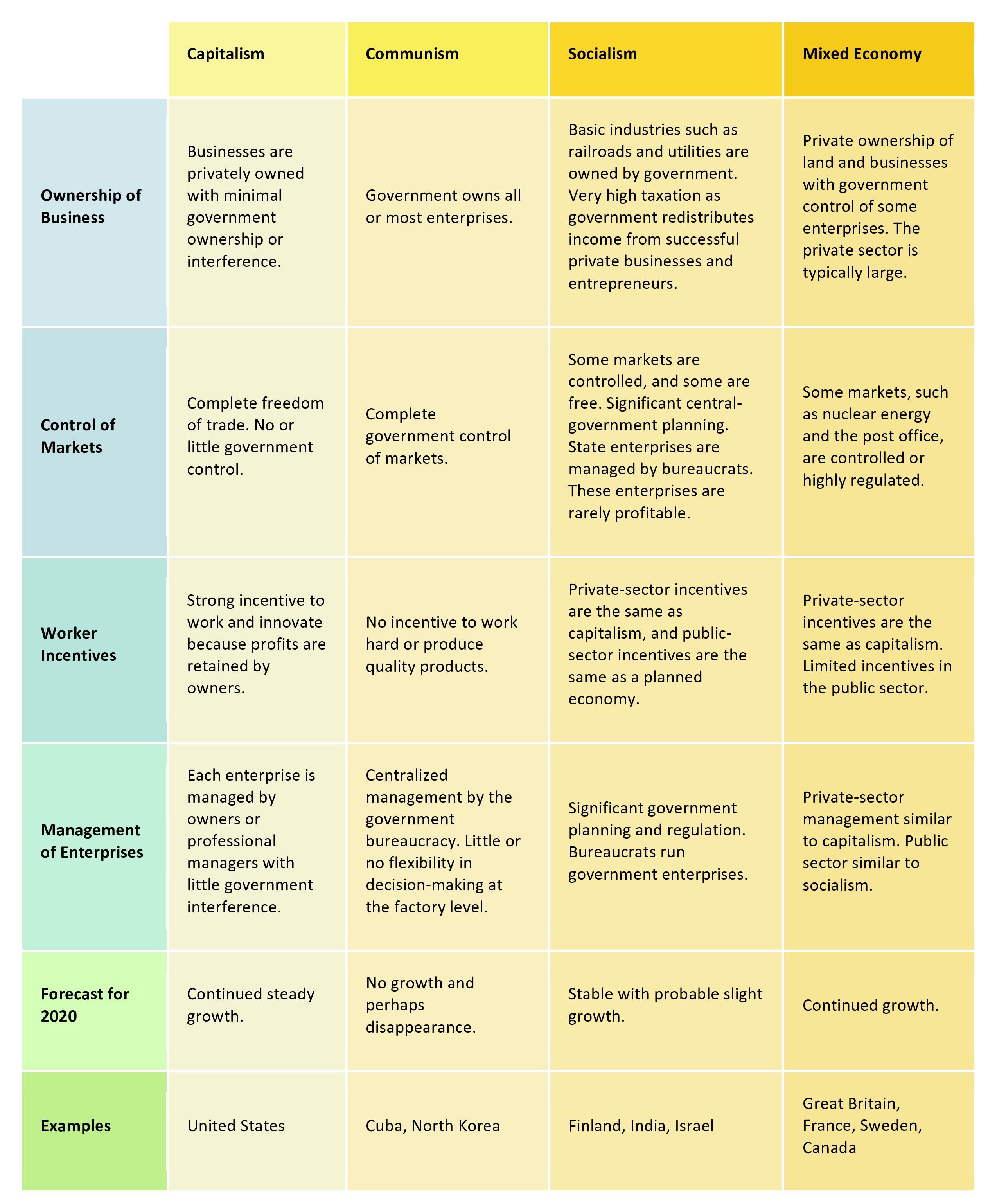
Capitalism
In recent years, more countries have shifted toward free-market economic systems and away from planned economies. Sometimes, as was the case of former East Germany, the transition to capitalism is painful but fairly quick. In other countries, such as Russia, the movement has been characterized by false starts and backsliding. Capitalism, also known as the private enterprise system, is based on competition in the marketplace and private ownership of the factors of production (resources). In a competitive economic system, a large number of people and businesses buy and sell products freely in the marketplace. In pure capitalism, all the factors of production are owned privately, and the government does not try to set prices or coordinate economic activity.
A capitalist system guarantees certain economic rights: the right to own property, the right to make a profit, the right to make free choices, and the right to compete. The right to own property is central to capitalism. The main incentive in this system is profit, which encourages entrepreneurship. Profit is also necessary for producing goods and services, building manufacturing plants, paying dividends and taxes, and creating jobs. The freedom to choose whether to become an entrepreneur or to work for someone else means that people have the right to decide what they want to do on the basis of their own drive, interest, and training. The government does not create job quotas for each industry or give people tests to determine what they will do.
Capitalism video: https://youtu.be/89H6BGdUyx0
Competition is good for both businesses and consumers in a capitalist system. It leads to better and more diverse products, keeps prices stable, and increases the efficiency of producers. Companies try to produce their goods and services at the lowest possible cost and sell them at the highest possible price. But when profits are high, more businesses enter the market to seek a share of those profits. The resulting competition among companies tends to lower prices. Companies must then find new ways of operating more efficiently if they are to keep making a profit—and stay in business.

Communism
The complete opposite of capitalism is communism. In a communist economic system, the government owns virtually all resources and controls all markets. Economic decision-making is centralized: the government, rather than the competitive forces in the marketplace, decides what will be produced, where it will be produced, how much will be produced, where the raw materials and supplies will come from, who will get the output, and what the prices will be. This form of centralized economic system offers little if any choice to a country’s citizens. Early in the 20th century, countries that chose communism, such as the former Soviet Union and China, believed that it would raise their standard of living. In practice, however, the tight controls over most aspects of people’s lives, such as what careers they can choose, where they can work, and what they can buy, led to lower productivity. Workers had no reasons to work harder or produce quality goods, because there were no rewards for excellence. Errors in planning and resource allocation led to shortages of even basic items.
These factors were among the reasons for the 1991 collapse of the Soviet Union into multiple independent nations. Recent reforms in Russia, China, and most of the eastern European nations have moved these economies toward more capitalistic, market-oriented systems. North Korea and Cuba are the best remaining examples of communist economic systems. Time will tell whether Cuba takes small steps toward a market economy now that the United States re-established diplomatic relations with the island country a few years ago.12
Socialism
Socialism is an economic system in which the basic industries are owned by the government or by the private sector with strong government control. A socialist state controls critical, large-scale industries such as transportation, communications, and utilities. Smaller businesses and those considered less critical, such as retail, may be privately owned. To varying degrees, the state also determines the goals of businesses, the prices and selection of goods, and the rights of workers. Socialist countries typically provide their citizens with a higher level of services, such as health care and unemployment benefits, than do most capitalist countries. As a result, taxes and unemployment may also be higher in socialist countries. For example, in 2017, the top individual tax rate in France was 45 percent, compared to 39.6 percent in the United States. With both countries electing new presidents in 2017, tax cuts may be a campaign promise that both President Macron and President Trump take on as part of their overall economic agendas in the coming years.13
Many countries, including the United Kingdom, Denmark, India, and Israel, have socialist systems, but the systems vary from country to country. In Denmark, for example, most businesses are privately owned and operated, but two-thirds of the population is sustained by the state through government welfare programs.
Video on economic systems: https://youtu.be/B43YEW2FvDs
Mixed Economic Systems
Pure capitalism and communism are extremes; real-world economies fall somewhere between the two. The U.S. economy leans toward pure capitalism, but it uses government policies to promote economic stability and growth. Also, through policies and laws, the government transfers money to the poor, the unemployed, the elderly, and the disabled. American capitalism has produced some very powerful organizations in the form of large corporations, such as General Motors and Microsoft. To protect smaller firms and entrepreneurs, the government has passed legislation that requires that the giants compete fairly against weaker competitors.
Canada, Sweden, and the UK, among others, are also called mixed economies; that is, they use more than one economic system. Sometimes, the government is basically socialist and owns basic industries. In Canada, the government owns the communications, transportation, and utilities industries, as well as some of the natural-resource industries. It also provides health care to its citizens. But most other activity is carried on by private enterprise, as in a capitalist system. In 2016, UK citizens voted for Britain to leave the European Union, a move that will take two or more years to finalize. It is too early to tell what impact the Brexit decision will have on the UK economy and other economies around the world.14
The few factors of production owned by the government in a mixed economy include some public lands, the postal service, and some water resources. But the government is extensively involved in the economic system through taxing, spending, and welfare activities. The economy is also mixed in the sense that the country tries to achieve many social goals—income redistribution and retirement pensions, for example—that may not be attempted in purely capitalist systems.
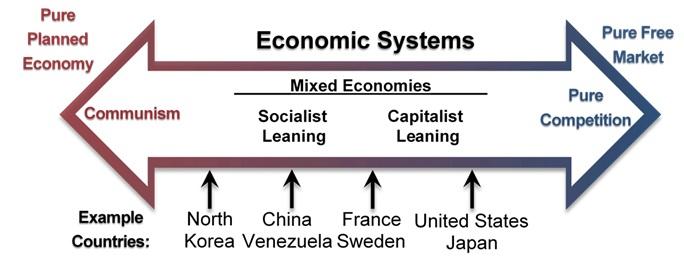
Macroeconomics and Microeconomics
The state of the economy affects both people and businesses. How you spend your money (or save it) is a personal economic decision. Whether you continue in school and whether you work part-time are also economic decisions. Every business also operates within the economy. Based on their economic expectations, businesses decide what products to produce, how to price them, how many people to employ, how much to pay these employees, how much to expand the business, and so on.
Economics has two main subareas. Macroeconomics is the study of the economy as a whole. It looks at aggregate data for large groups of people, companies, or products as a whole. In contrast, microeconomics focuses on individual parts of the economy, such as households or firms.
Micro vs Macro video: https://youtu.be/w8tUIq7Blsg
Both macroeconomics and microeconomics offer a valuable outlook on the economy. For example, Ford might use both to decide whether to introduce a new line of vehicles. The company would consider such macroeconomic factors as the national level of personal income, the unemployment rate, interest rates, fuel costs, and the national level of sales of new vehicles. From a microeconomic viewpoint, Ford would judge consumer demand for new vehicles versus the existing supply, competing models, labor and material costs and availability, and current prices and sales incentives.
Economics as a Circular Flow
Another way to see how the sectors of the economy interact is to examine the circular flow of inputs and outputs among households, businesses, and governments as shown in Exhibit 1.3. Let’s review the exchanges by following the red circle around the inside of the diagram. Households provide inputs (natural resources, labor, capital, entrepreneurship, knowledge) to businesses, which convert these inputs into outputs (goods and services) for consumers. In return, households receive income from rent, wages, interest, and ownership profits (blue circle). Businesses receive revenue from consumer purchases of goods and services.
The other important exchange in Exhibit 1.3 takes place between governments (federal, provincial, and local) and both households and businesses. Governments supply many types of publicly provided goods and services (highways, schools, police, courts, health services, unemployment insurance, social security) that benefit consumers and businesses. Government purchases from businesses also contribute to business revenues. When a construction firm repairs a local stretch of state highway, for example, government pays for the work. As the diagram shows, government receives taxes from households and businesses to complete the flow.
Changes in one flow affect the others. If government raises taxes, households have less to spend on goods and services. Lower consumer spending causes businesses to reduce production, and economic activity declines; unemployment may rise. In contrast, cutting taxes can stimulate economic activity. Keep the circular flow in mind as we continue our study of economics. The way economic sectors interact will become more evident as we explore macroeconomics and microeconomics.

1.4 Macroeconomics: The Big Picture
How does economic growth, full employment, price stability, and inflation indicate a nation’s economic health?
Have you ever looked at the news on a mobile device or turned on the radio and heard something like, “Today Statistics Canada reported that for the second straight month unemployment declined?” Statements like this are macroeconomic news. Understanding the national economy and how changes in government policies affect households and businesses is a good place to begin our study of economics.
Let’s look first at macroeconomic goals and how they can be met. Canada and most other countries have three main macroeconomic goals: economic growth, full employment, and price stability. A nation’s economic well-being depends on carefully defining these goals and choosing the best economic policies to achieve them.
Striving for Economic Growth
Perhaps the most important way to judge a nation’s economic health is to look at its production of goods and services. The more the nation produces, the higher its standard of living. An increase in a nation’s output of goods and services is economic growth.
The most basic measure of economic growth is the gross domestic product (GDP). GDP is the total market value of all final goods and services produced within a nation’s borders each year. Statistics Canada publishes quarterly GDP figures that can be used to compare trends in national output. When GDP rises, the economy is growing.
The rate of growth in real GDP (GDP adjusted for inflation) is also important. Recently, the Canadian economy has been growing at a slow but steady rate. This growth rate has meant a steady increase in the output of goods and services and relatively low unemployment. When the growth rate slides toward zero, the economy begins to stagnate and decline.
One country that continues to grow more rapidly than most is China, whose GDP has been growing at 6 to 7 percent per year. Today few things in the global marketplace are not or cannot be made in China. The primary contributor to China’s rapid growth has been technology. For example, most tablets and laptops are manufactured in China.
The level of economic activity is constantly changing. These upward and downward changes are called business cycles. Business cycles vary in length, in how high or low the economy moves, and in how much the economy is affected. Changes in GDP trace a pattern as economic activity expands and contracts. An increase in business activity results in rising output, income, employment, and prices. Eventually, these all peak, and output, income, and employment decline. A decline in GDP that lasts for two consecutive quarters (each a three-month period) is called a recession. It is followed by a recovery period when economic activity once again increases. The most recent recession began in December 2007 and ended in June 2009.
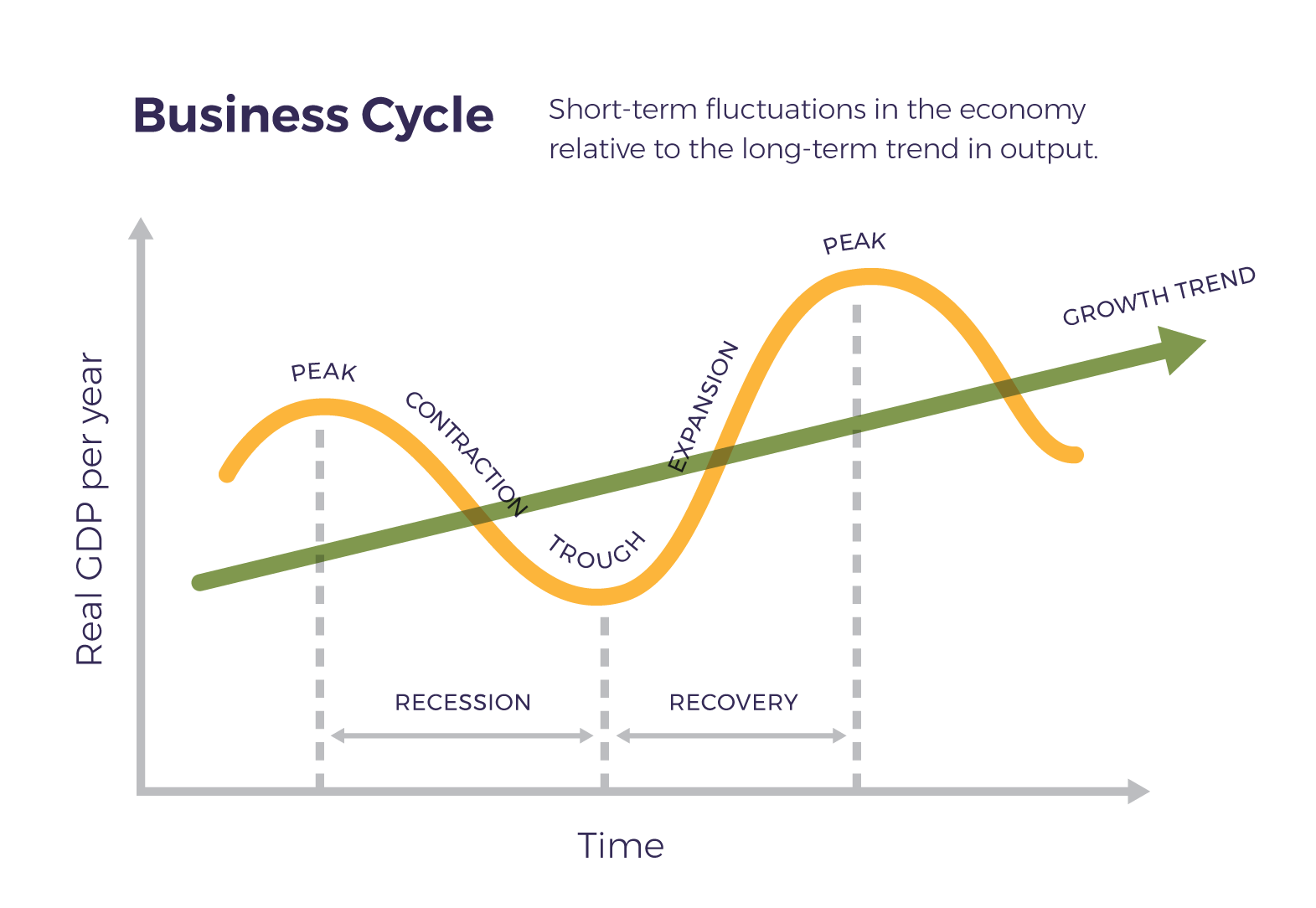
Businesses must monitor and react to the changing phases of business cycles. When the economy is growing, companies often have a difficult time hiring good employees and finding scarce supplies and raw materials. When a recession hits, many firms find they have more capacity than the demand for their goods and services requires. During the most recent recession, many businesses operated at substantially lower than capacity. When plants use only part of their capacity, they operate inefficiently and have higher costs per unit produced. Let’s say that Mars Corp. has a huge plant that can produce one million Milky Way candy bars a day, but because of a recession Mars can sell only half a million candy bars a day. The plant uses large, expensive machines. Producing Milky Ways at 50 percent capacity does not efficiently utilize Mars’s investment in its plant and equipment.
Keeping People on the Job
Another macroeconomic goal is full employment or having jobs for all who want to and can work. Full employment doesn’t actually mean 100 percent employment. Some people choose not to work for personal reasons (attending school, raising children) or are temporarily unemployed while they wait to start a new job. Thus, the government defines full employment as the situation when about 94 to 96 percent of those available to work actually have jobs.
Maintaining low unemployment levels is of concern not just to Canada but also to countries around the world. For example, high youth unemployment rates (for workers 25 years of age and younger) in Spain, Italy, and Greece continue to cause protests in these European countries as elected officials struggle with how to turn around their respective economies and put more people, particularly young people, back to work. The UK’s impending exit from the European Union may also have an effect on unemployment rates, as global companies move jobs out of Britain to central European countries such as Poland.15
Measuring Unemployment
To determine how close we are to full employment, the government measures the unemployment rate. This rate indicates the percentage of the total labor force that is not working but is actively looking for work. It excludes “discouraged workers,” those not seeking jobs because they think no one will hire them. Each month Statistics Canada releases statistics on employment. These figures help us understand how well the economy is doing.
Types of Unemployment
Economists classify unemployment into four types: frictional, structural, cyclical, and seasonal. The categories are of small consolation to someone who is unemployed, but they help economists understand the problem of unemployment in our economy.
Frictional unemployment is short-term unemployment that is not related to the business cycle. It includes people who are unemployed while waiting to start a better job, those who are re-entering the job market, and those entering for the first time, such as new college graduates. This type of unemployment is always present and has little impact on the economy.
Structural unemployment is also unrelated to the business cycle but is involuntary. It is caused by a mismatch between available jobs and the skills of available workers in an industry or a region. For example, if the birthrate declines, fewer teachers will be needed. Or the available workers in an area may lack the skills that employers want. Retraining and skill-building programs are often required to reduce structural unemployment.
Cyclical unemployment, as the name implies, occurs when a downturn in the business cycle reduces the demand for labour throughout the economy. In a long recession, cyclical unemployment is widespread and even people with good job skills can’t find jobs. The government can partly counteract cyclical unemployment with programs that boost the economy.
In the past, cyclical unemployment affected mainly less-skilled workers and those in heavy manufacturing. Typically, they would be rehired when economic growth increased. Since the 1990s, however, competition has forced many Canadian companies to downsize so they can survive in the global marketplace. These job reductions affected workers in all categories, including middle management and other salaried positions. Firms continue to re-evaluate workforce requirements and downsize to stay competitive to compete with Asian, European, U.S. and other Canadian firms. After a strong rebound from the global recession of 2007–2009, when the auto industry slashed more than 200,000 hourly and salaried workers from their payrolls, the automakers are now taking another close look at the size of their global workforces. For example, as sales steadily rose after the recession, Ford Motor Company’s workforce in North America increased by 25 percent over the past five years. As car sales plateaued in 2017, the company recently announced it would cut approximately 10 percent of its global workforce in an effort to reduce costs, boost profits, and increase its stock value for shareholders.16
The last type is seasonal unemployment, which occurs during specific times of the year in certain industries. Employees subject to seasonal unemployment include retail workers hired for the holiday shopping season, fruit pickers in British Columbia, and restaurant employees in ski country during the summer.
Types of unemployment video: https://youtu.be/ZckAN1KYB5I
Keeping Prices Steady
The third macroeconomic goal is to keep overall prices of goods and services fairly steady. The situation in which the average of all prices of goods and services is rising is called inflation. Inflation’s higher prices reduce purchasing power, the value of what money can buy. Purchasing power is influenced by two things: inflation and income. If incomes rise at the same rate as inflation, there is no change in purchasing power. If prices go up but income doesn’t rise or rises at a slower rate, a given amount of income buys less, and purchasing power falls. For example, if the price of a basket of groceries rises from $30 to $40 but your salary remains the same, you can buy only 75 percent as much groceries ($30 ÷ $40) for $30. Your purchasing power declines by 25 percent ($10 ÷ $40). If incomes rise at a rate faster than inflation, then purchasing power increases. You can, in fact, have rising purchasing power even if inflation is increasing. Typically, however, inflation rises faster than incomes, leading to a decrease in purchasing power.

Inflation affects both personal and business decisions. When prices are rising, people tend to spend more—before their purchasing power declines further. Businesses that expect inflation often increase their supplies, and people often speed up planned purchases of cars and major appliances.
Some nations have had high double and even triple-digit inflation in recent years. As of early 2017, the monthly inflation rate in Venezuela was an astounding 741 percent, followed by the African country of South Sudan at 273 percent.17
Types of Inflation
There are two types of inflation. Demand-pull inflation occurs when the demand for goods and services is greater than the supply. Would-be buyers have more money to spend than the amount needed to buy available goods and services. Their demand, which exceeds the supply, tends to pull prices up. This situation is sometimes described as “too much money chasing too few goods.” The higher prices lead to greater supply, eventually creating a balance between demand and supply.
Cost-push inflation is triggered by increases in production costs, such as expenses for materials and wages. These increases push up the prices of final goods and services. Wage increases are a major cause of cost-push inflation, creating a “wage-price spiral.” For example, assume the Canadian Auto Workers union negotiates a three-year labour agreement that raises wages 3 percent per year and increases overtime pay. Carmakers will then raise car prices to cover their higher labour costs. Also, the higher wages will give autoworkers more money to buy goods and services, and this increased demand may pull up other prices. Workers in other industries will demand higher wages to keep up with the increased prices, and the cycle will push prices even higher.
How Inflation Is Measured
The rate of inflation is most commonly measured by looking at changes in the consumer price index (CPI), an index of the prices of a “market basket” of goods and services purchased by typical urban consumers. It is published monthly by Statistics Canada. Major components of the CPI, which are weighted by importance, are food and beverages, clothing, transportation, housing, medical care, recreation, and education. There are special indexes for food and energy.
CPI video: https://youtu.be/qfKmJe3CK6E
Changes in wholesale prices are another important indicator of inflation. The producer price index (PPI) measures the prices paid by producers and wholesalers for various commodities, such as raw materials, partially finished goods, and finished products.
The Impact of Inflation
Inflation has several negative effects on people and businesses. For one thing, inflation penalizes people who live on fixed incomes. Let’s say that a couple receives $2,000 a month retirement income beginning in 2018. If inflation is 10 percent in 2019, then the couple can buy only about 91 percent (100 ÷ 110) of what they could purchase in 2018. Similarly, inflation hurts savers. As prices rise, the real value, or purchasing power, of a nest egg of savings deteriorates.
1.5 Achieving Macroeconomic Goals
How does the government use monetary policy and fiscal policy to achieve its macroeconomic goals?
To reach macroeconomic goals, countries must often choose among conflicting alternatives. Sometimes political needs override economic needs. For example, bringing inflation under control may call for a politically difficult period of high unemployment and low growth. Or, in an election year, politicians may resist raising taxes to curb inflation. Still, the government must try to guide the economy to a sound balance of growth, employment, and price stability. The two main tools it uses are monetary policy and fiscal policy.
Monetary Policy
Monetary policy is exercised by The Bank of Canada, which is empowered to take various actions that decrease or increase the money supply and raise or lower short-term interest rates, making it harder or easier to borrow money. When The Bank of Canada believes that inflation is a problem, it will use contractionary policy to decrease the money supply and raise interest rates. When rates are higher, borrowers have to pay more for the money they borrow, and banks are more selective when making loans. Because money is “tighter”—more expensive to borrow—demand for goods and services will go down, and so will prices. In any case, that’s the theory. The Bank of Canada will typically tighten or decrease the money supply during inflationary periods, making it harder to borrow money.
To counter a recession, The Bank of Canada uses expansionary policy to increase the money supply and reduce interest rates. With lower interest rates, it’s cheaper to borrow money, and banks are more willing to lend it. We then say that money is “easy.” Attractive interest rates encourage businesses to borrow money to expand production and encourage consumers to buy more goods and services especially more expensive things like cars and houses which require them to borrow money. In theory, both sets of actions will help the economy escape or come out of a recession.
Source: ECAMPUS
Fiscal Policy
Fiscal policy relies on the government’s powers of spending and taxation. Both taxation and government spending can be used to reduce or increase the total supply of money in the economy—the total amount, in other words, that businesses and consumers have to spend. When the country is in a recession, government policies typically increase spending, reduce taxes, or both. Such expansionary actions will put more money in the hands of businesses and consumers, encouraging businesses to expand and consumers to buy more goods and services. Expansionary fiscal policy is used to increase government expenditures and/or decrease taxes which causes the government’s budget deficit to increase or its budget surplus to decrease. When the economy is experiencing inflation, the opposite policy is adopted. Contractionary fiscal policy is used to decrease government expenditures and/or increase taxes which causes the government’s budget deficit to decrease or its budget surplus to increase. Because such contractionary measures reduce spending by businesses and consumers, prices come down and inflation eases.
Source: ECAMPUS
The National Debt
If, in any given year, the government takes in more money (through taxes) than it spends on goods and services (for things such as defence, transportation, and social services), the result is a budget surplus. If, on the other hand, the government spends more than it takes in, we have a budget deficit. Historically, deficits have occurred much more often than surpluses; typically, the government spends more than it takes in. Consequently, the Canadian government now has a total national debt of more than $1.4 trillion. Just like you as a student, if you spend more each month than you bring in from a part-time job, you will build up debt.
This number is moving too quickly for the authors to keep the graph current – you can see the current debt at https://www.nationaldebtclocks.org/debtclock/canada.
Source: ECAMPUS
1.6 Microeconomics: Zeroing in on Businesses and Consumers
What are the basic microeconomic concepts of demand and supply, and how do they establish prices?
Now let’s shift our focus from the whole economy to microeconomics, the study of households, businesses, and industries. This field of economics is concerned with how prices and quantities of goods and services behave in a free market. It stands to reason that people, firms, and governments try to get the most from their limited resources. Consumers want to buy the best quality at the lowest price. Businesses want to keep costs low and revenues high to earn larger profits. Governments also want to use their revenues to provide the most effective public goods and services possible. These groups choose among alternatives by focusing on the prices of goods and services.
As consumers in a free market, we influence what is produced. If Mexican food is popular, the high demand attracts entrepreneurs who open more Mexican restaurants. They want to compete for our dollars by supplying Mexican food at a lower price, of better quality, or with different features, such as Santa Fe Mexican food rather than Tex-Mex. This section explains how business and consumer choices influence the price and availability of goods and services.
Supply and demand video: https://youtu.be/AHh_toZGypw

The Nature of Demand
Demand is the quantity of a good or service that people are willing to buy at various prices. The higher the price, the lower the quantity demanded, and vice versa. A graph of this relationship is called a demand curve.
Let’s assume you own a store that sells jackets for snowboarders. From past experience, you know how many jackets you can sell at different prices. The demand curve in Exhibit 1.6 depicts this information. The x-axis (horizontal axis) shows the quantity of jackets, and the y-axis (vertical axis) shows the related price of those jackets. For example, at a price of $100, customers will buy (demand) 600 snowboard jackets.
In the graph, the demand curve slopes downward and to the right because as the price falls, people will want to buy more jackets. Some people who were not going to buy a jacket will purchase one at the lower price.
Also, some snowboarders who already have a jacket will buy a second one. The graph also shows that if you put a large number of jackets on the market, you will have to reduce the price to sell all of them. Understanding demand is critical to businesses. Demand tells you how much you can sell and at what price—in other words, how much money the firm will earn to cover costs and hopefully earn a profit. Gauging demand is difficult even for large corporations, but particularly for small firms.

The Nature of Supply
Demand alone is not enough to explain how the market sets prices. We must also look at supply, the quantity of a good or service that businesses will make available at various prices. The higher the price, the greater the number of jackets a supplier will supply, and vice versa. A graph of the relationship between various prices and the quantities a business will supply is a supply curve.
We can again plot the quantity of jackets on the x-axis and the price on the y-axis. As Exhibit 1.7 shows, 800 jackets will be available at a price of $100. Note that the supply curve slopes upward and to the right, the opposite of the demand curve. If snowboarders are willing to pay higher prices, suppliers of jackets will buy more inputs (for example, Gore-Tex® fabric, dye, machinery, labour) and produce more jackets. The quantity supplied will be greater at higher prices because manufacturers can earn higher profits.

How Demand and Supply Interact to Determine Prices
In a stable economy, the number of jackets that snowboarders demand depends on the jackets’ price. Likewise, the number of jackets that suppliers provide depends on price. But at what price will consumer demand for jackets match the quantity suppliers will produce?
To answer this question, we need to look at what happens when demand and supply interact. By plotting both the demand curve and the supply curve on the same graph in Exhibit 1.8, we see that they cross at a certain quantity and price. At that point, labeled E, the quantity demanded equals the quantity supplied. This is the point of equilibrium. The equilibrium price is $80 and the equilibrium quantity is 700 jackets. At that point, there is a balance between the quantity consumers will buy and the quantity suppliers will make available.
Market equilibrium is achieved through a series of quantity and price adjustments that occur automatically. If the price increases to $160, suppliers produce more jackets than consumers are willing to buy, resulting in a surplus. To sell more jackets, prices will have to fall. Thus, a surplus pushes prices downward until equilibrium is reached. When the price falls to $60, the quantity of jackets demanded rises above the available supply. The resulting shortage forces prices upward until equilibrium is reached at $80.

1.7 Competing in a Free Market
What are the four types of market structure?
One of the characteristics of a free-market system is that suppliers have the right to compete with one another. The number of suppliers in a market defines the market structure. Economists identify four types of market structures: perfect competition, pure monopoly, monopolistic competition, and oligopoly.
Table 1.2 summarizes the characteristics of each of these market structures.
Perfect Competition
Characteristics of perfect (pure) competition include:
- A large number of small firms are in the market.
- The firms sell similar products; that is, each firm’s product is very much like the products sold by other firms in the market.
- Buyers and sellers in the market have good information about prices, sources of supply, and so on.
It is easy to open a new business or close an existing one.
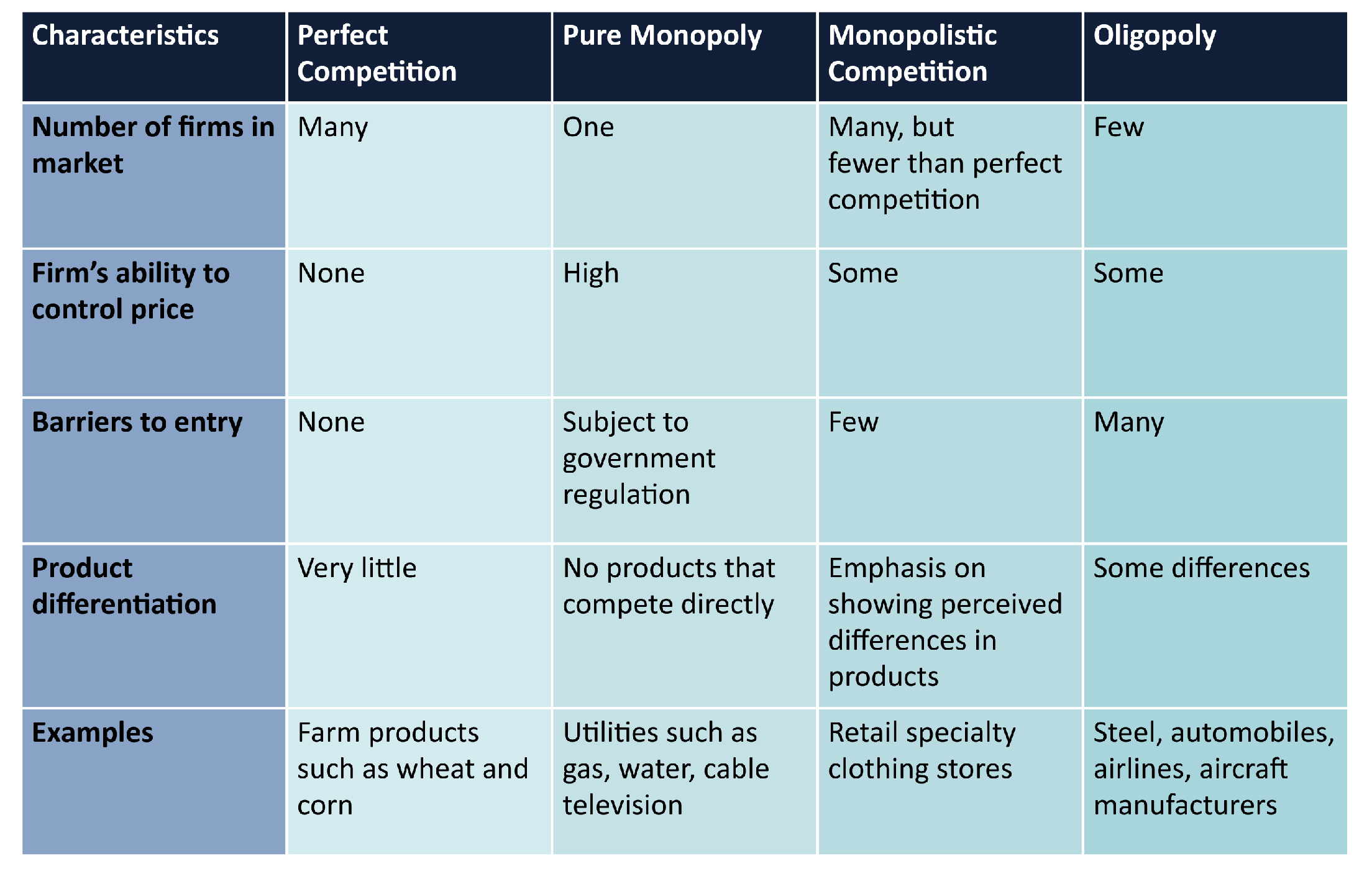
In a perfectly competitive market, firms sell their products at prices determined solely by forces beyond their control. Because the products are very similar and each firm contributes only a small amount to the total quantity supplied by the industry, price is determined by supply and demand. A firm that raised its price even a little above the going rate would lose customers. In the wheat market, for example, the product is essentially the same from one wheat producer to the next. Thus, none of the producers has control over the price of wheat.
Perfect competition is the ideal market structure for both businesses and consumers. No industry has perfect competition, but the stock market and some agricultural markets, such as wheat and corn, come closest. Farmers, for example, can sell all of their crops through national commodity exchanges at the current market price.
Pure Monopoly
At the other end of the spectrum is pure monopoly, the market structure in which a single firm accounts for all industry sales of a particular good or service. The firm is the industry. This market structure is characterized by barriers to entry—factors that prevent new firms from competing equally with the existing firm. Often the barriers are technological or legal conditions. Polaroid, for example, held major patents on instant photography for years. When Kodak tried to market its own instant camera, Polaroid sued, claiming patent violations. Polaroid collected millions of dollars from Kodak. Another barrier may be one firm’s control of a natural resource. DeBeers Consolidated Mines Ltd., for example, controls most of the world’s supply of uncut diamonds.
Public utilities, such as gas and water companies, are pure monopolies. Some monopolies are created by the government to outlaw competition. Canada Post is currently one such monopoly.
Monopolistic Competition
Three characteristics define the market structure known as monopolistic competition:
- Many firms are in the market.
- The firms offer products that are close substitutes but still differ from one another.
- It is relatively easy to enter the market.
Under monopolistic competition, firms take advantage of product differentiation. Industries where monopolistic competition occurs include clothing, food, and similar consumer products. Firms under monopolistic competition have more control over pricing than do firms under perfect competition because consumers do not view the products as perfect substitutes. Nevertheless, firms must demonstrate product differences to justify their prices to customers. Consequently, companies use advertising to distinguish their products from others. Such distinctions may be significant or superficial. For example, Nike says “Just Do It,” and Tylenol is advertised as being easier on the stomach than aspirin.
Oligopoly
An oligopoly has two characteristics:
- A few firms produce most or all of the output.
- Large capital requirements or other factors limit the number of firms.
Boeing and Airbus Industries (aircraft manufacturers) and Apple and Google (operating systems for smartphones) are major players in different oligopolistic industries. With so few firms in an oligopoly, what one firm does has an impact on the other firms. Thus, the firms in an oligopoly watch one another closely for new technologies, product changes and innovations, promotional campaigns, pricing, production, and other developments. Sometimes they go so far as to coordinate their pricing and output decisions, which is illegal.
Key Terms
